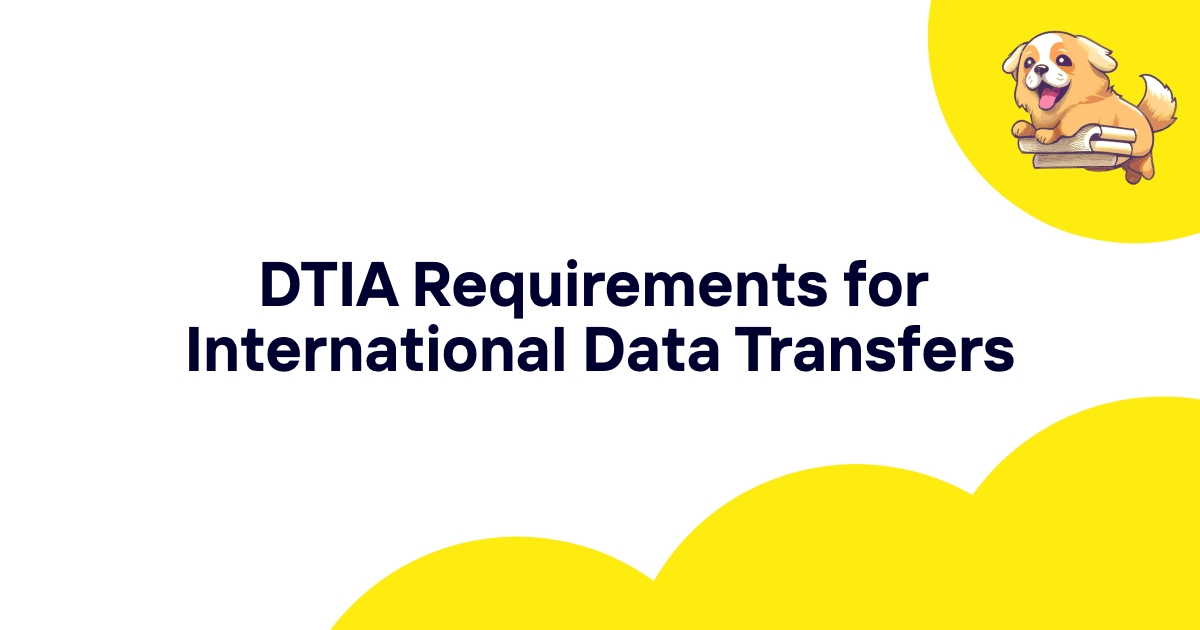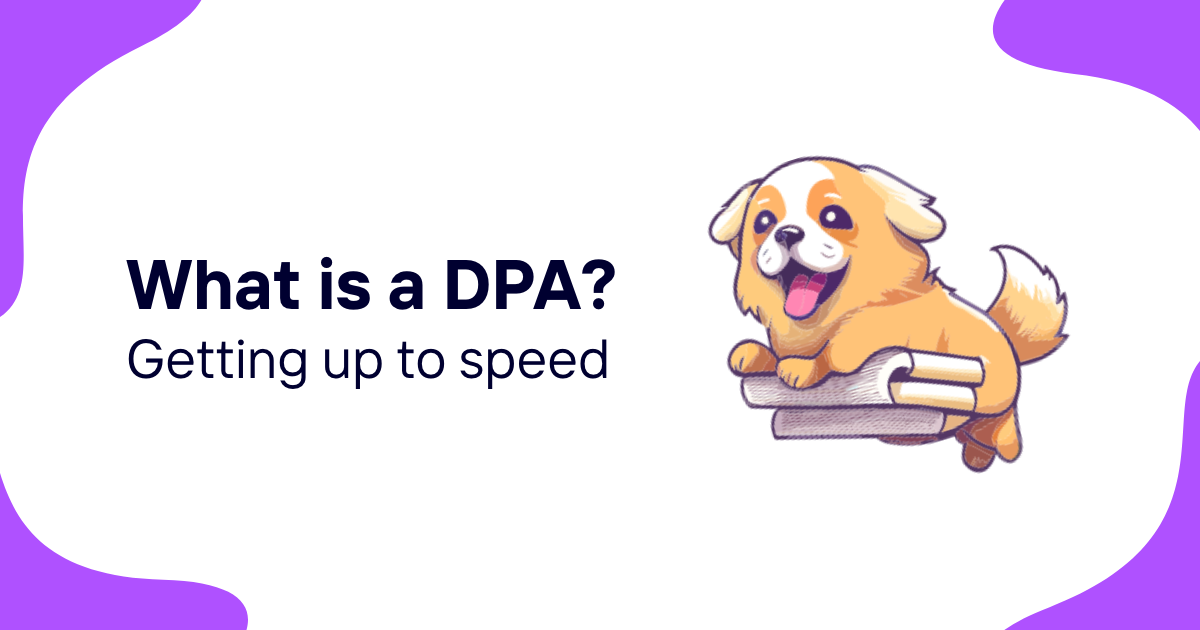When organizations move personal data across international borders, they step into a regulatory minefield that requires careful navigation. Data Transfer Impact Assessments (DTIAs) serve as the essential roadmap for companies processing European data outside the EU, EEA, or UK jurisdictions.
The regulatory landscape has shifted dramatically since the Schrems II ruling fundamentally changed how businesses approach international data transfers. Organizations can no longer rely solely on adequacy decisions or standard contractual clauses without conducting thorough risk assessments of the destination countries.
This shift affects virtually every business with a digital presence. Whether you're a startup using cloud services or a multinational corporation with global operations, understanding DTIA requirements has become a business-critical competency.
Table of contents
- What is a Data Transfer Impact Assessment
- Legal foundation and regulatory requirements
- When DTIAs are mandatory
- Countries requiring DTIA assessments
- Step-by-step DTIA implementation process
- Transfer mechanisms and safeguards
- Risk assessment framework
- Supplementary measures for data protection
- Documentation and compliance records
- Common implementation challenges
- Industry-specific considerations
- Regular monitoring and updates
- Building a sustainable compliance program
What is a Data Transfer Impact Assessment
A Data Transfer Impact Assessment represents a systematic evaluation process that organizations must conduct before transferring personal data to countries outside the European Economic Area. Think of it as a due diligence checklist that examines both legal and practical risks associated with international data flows.
The assessment goes beyond simple checkbox compliance. It requires organizations to examine the receiving country's surveillance laws, data protection frameworks, and government access powers that could undermine GDPR protections.
DTIAs emerged as a direct response to privacy advocates' concerns about inadequate protection levels in certain jurisdictions. The assessment process forces companies to think critically about where their data goes and what happens to it once it crosses borders.
The scope of a DTIA extends to both direct transfers (when your organization sends data directly) and onward transfers (when your service providers or sub-processors move data to additional parties). This comprehensive approach ensures that data protection travels with the information throughout the entire processing chain.
Legal foundation and regulatory requirements
The legal basis for DTIAs stems from Articles 44-49 of the GDPR, which establish the framework for international data transfers. These provisions require that any transfer to a third country maintains an "adequate level of protection" for personal data.
The European Data Protection Board's Recommendations 01/2020 provide detailed guidance on conducting transfer impact assessments. These recommendations became particularly relevant after the Court of Justice invalidated the EU-US Privacy Shield framework in the Schrems II decision.
GDPR enforcement has shown that regulators take transfer violations seriously. Recent fines have targeted organizations that failed to conduct proper assessments before moving data internationally, with penalty amounts reaching millions of euros.
The legal framework operates on a risk-based approach. Organizations must demonstrate that they've evaluated potential threats and implemented appropriate safeguards rather than simply relying on contractual arrangements.
When DTIAs are mandatory
DTIAs become mandatory in specific circumstances that many organizations encounter daily. The most common trigger occurs when transferring personal data to countries without adequacy decisions from the European Commission.
Organizations using cloud services frequently find themselves in DTIA territory. If your customer relationship management system, email provider, or data analytics platform operates servers in countries like the United States (outside DPF-certified companies), Australia, or India, you'll need to conduct assessments.
The requirement also applies when using Standard Contractual Clauses as your transfer mechanism. Even though SCCs provide contractual protection, they don't automatically guarantee adequate protection levels in the destination country.
Government surveillance powers create another mandatory scenario. Countries with broad intelligence gathering capabilities or weak judicial oversight mechanisms typically require detailed impact assessments regardless of other safeguards.
Sub-processor relationships add complexity to DTIA requirements. When your primary service provider engages additional processors in third countries, you may need to assess the entire processing chain rather than just the initial transfer.
Countries requiring DTIA assessments
Understanding which destinations require DTIAs helps organizations plan their international operations and vendor relationships. Countries fall into three broad categories based on their regulatory recognition status.
Adequate countries have received positive adequacy decisions from the European Commission, meaning transfers can proceed without additional safeguards. This list includes:
| Country | Adequacy Status | Special Conditions |
|---|---|---|
| Canada | Commercial organizations | Private sector only |
| Japan | General adequacy | Full recognition |
| New Zealand | General adequacy | Full recognition |
| South Korea | General adequacy | Full recognition |
| Switzerland | General adequacy | Full recognition |
| United Kingdom | General adequacy | Post-Brexit recognition |
Countries requiring DTIAs lack adequacy decisions and present varying risk levels depending on their legal frameworks:
- Australia: Strong privacy laws but broad government access powers
- Brazil: GDPR-aligned legislation but limited enforcement history
- India: Comprehensive surveillance framework with wide government access
- Mexico: Data protection laws but jurisdiction concerns for international transfers
- Philippines: Anti-terrorism legislation allowing extensive data access
- Singapore: Generally strong privacy protections but government surveillance capabilities
- Turkey: Extensive intelligence gathering powers with extraterritorial reach
The United States presents a unique situation. Companies participating in the Data Privacy Framework receive adequacy treatment, while others require DTIAs and supplementary measures.
Step-by-step DTIA implementation process
Implementing a DTIA requires systematic evaluation across multiple dimensions. The process begins with comprehensive data mapping to understand what information moves where and why.
Step 1: Transfer scope identification
Document the complete data transfer landscape including data categories, processing purposes, recipient entities, and storage locations. This inventory forms the foundation for risk assessment activities.
Organizations often discover unexpected data flows during this phase. Marketing automation platforms, customer support systems, and backup services frequently involve international transfers that weren't initially obvious.
Step 2: Legal framework evaluation
Analyze the destination country's data protection laws, enforcement mechanisms, and government access powers. This evaluation requires understanding both written laws and practical implementation realities.
Key factors include judicial oversight requirements for government data access, data subject rights enforcement mechanisms, and the independence of data protection authorities.
Step 3: Risk identification and analysis
Examine potential threats to data subjects' rights and freedoms. Common risks include government surveillance programs, weak privacy law enforcement, and inadequate redress mechanisms.
Consider both theoretical risks (what laws permit) and practical risks (how authorities actually behave). Some countries have broad surveillance laws but limited practical implementation, while others may have narrower laws but aggressive enforcement.
Step 4: Supplementary measures implementation
Deploy technical, contractual, and organizational safeguards to mitigate identified risks. The effectiveness of these measures depends on the specific risks and transfer circumstances.
Technical measures might include encryption, pseudonymization, or data minimization. Contractual measures could involve enhanced notification requirements or government access challenge clauses.
Transfer mechanisms and safeguards
Organizations have several legal mechanisms available for international data transfers, each with different implementation requirements and risk profiles.
Standard Contractual Clauses represent the most widely used transfer mechanism. The European Commission's updated clauses include specific DTIA requirements and enhanced protection obligations.
SCCs alone aren't sufficient when destination countries have problematic surveillance laws. Organizations must implement supplementary measures to address specific risks identified in their DTIA process.
Binding Corporate Rules provide an alternative for multinational organizations wanting to streamline intra-group transfers. BCRs require approval from EU data protection authorities but offer more flexibility once approved.
The approval process involves demonstrating comprehensive data protection standards across all group entities and jurisdictions. Organizations typically need 12-18 months to obtain BCR approval.
Adequacy frameworks like the EU-US Data Privacy Framework provide streamlined transfer options for participating organizations. However, participation requires ongoing compliance monitoring and certification maintenance.
Derogations under Article 49 GDPR offer limited options for specific transfer scenarios. These exceptions apply to situations like explicit consent, contract performance, or public interest transfers, but they can't support systematic transfer programs.
Risk assessment framework
Effective DTIA implementation requires a structured approach to risk evaluation that considers both legal and practical factors affecting data protection.
Government access assessment forms the core of most DTIAs. This evaluation examines laws permitting intelligence agencies, law enforcement, and other government bodies to access personal data.
Consider oversight mechanisms, proportionality requirements, and notification obligations. Countries with independent judicial review typically present lower risks than those with executive-only authorization processes.
Legal system evaluation extends beyond data protection to examine broader rule of law factors. Independent judiciary systems, corruption levels, and human rights records all influence data protection effectiveness.
Enforcement capability assessment evaluates whether data protection authorities have sufficient resources, independence, and legal powers to protect data subjects' rights.
Redress mechanism analysis examines available options for data subjects to challenge unlawful processing or government access. Effective redress requires accessible procedures, independent decision-makers, and enforceable remedies.
The assessment should consider cumulative risks rather than evaluating factors in isolation. A country might have adequate privacy laws but problematic government access powers that undermine overall protection levels.
Supplementary measures for data protection
When DTIAs identify significant risks, organizations must implement additional safeguards beyond basic transfer mechanisms. These measures fall into three categories: technical, contractual, and organizational.
Technical measures provide the strongest protection by making data inaccessible or unusable even if unlawfully accessed:
- End-to-end encryption with EU-controlled keys
- Pseudonymization with EU-held identifier mappings
- Data minimization and purpose limitation
- Secure multi-party computation for analytics
Technical measures work best when they're built into systems from the ground up rather than added retroactively.
Contractual measures enhance legal protections through additional obligations and procedures:
- Government access notification requirements (where legally possible)
- Legal challenge obligations for unlawful access requests
- Enhanced audit rights and transparency reporting
- Data location and processing restrictions
Organizational measures establish governance frameworks and operational procedures:
- Regular legal framework monitoring in destination countries
- Staff training on international transfer requirements
- Incident response procedures for government access requests
- Vendor due diligence and ongoing monitoring programs
The effectiveness of supplementary measures depends on specific risk scenarios. Encryption provides strong protection against general surveillance but may be less effective against targeted law enforcement requests with technical assistance orders.
Documentation and compliance records
Comprehensive documentation serves multiple purposes: demonstrating compliance to regulators, supporting ongoing risk management, and enabling effective incident response.
DTIA records should include risk assessment methodology, identified threats, implemented safeguards, and regular review schedules. Documentation must be detailed enough to reconstruct decision-making processes during regulatory inquiries.
Organizations often struggle with documentation scope and detail. Records should focus on material risks and mitigation strategies rather than exhaustive legal analysis of every possible scenario.
Transfer inventories maintain current information about data flows, processing purposes, and recipient locations. These inventories require regular updates as business operations and vendor relationships change.
Safeguard monitoring records track the ongoing effectiveness of implemented measures. This might include encryption key management logs, vendor audit results, or government access request statistics.
Review documentation demonstrates that organizations regularly reassess transfer risks and update safeguards as conditions change. Reviews should occur at least annually or when significant legal or operational changes occur.
Common implementation challenges
Organizations face several recurring obstacles when implementing DTIA programs, often related to resource constraints, technical complexity, or organizational coordination.
Resource allocation represents a persistent challenge. DTIAs require legal expertise, technical knowledge, and ongoing monitoring capabilities that many organizations lack internally.
Small and medium enterprises particularly struggle with DTIA implementation costs relative to their compliance budgets. However, the risks of non-compliance often outweigh implementation expenses.
Vendor management complexity increases exponentially with international operations. Organizations must track sub-processor relationships, monitor location changes, and coordinate safeguard implementation across multiple parties.
Technical implementation of supplementary measures often requires significant system changes or new infrastructure investments. Organizations must balance protection effectiveness with operational efficiency.
Legal uncertainty in rapidly changing regulatory environments makes it difficult to predict future compliance requirements. Organizations need flexible frameworks that can adapt to regulatory developments.
Cross-border coordination becomes challenging when different jurisdictions have conflicting requirements or when subsidiaries operate under different legal frameworks.
Industry-specific considerations
Different sectors face unique DTIA challenges based on their regulatory environments, data sensitivity levels, and operational requirements.
Financial services organizations deal with extensive cross-border data flows for transaction processing, risk management, and regulatory reporting. They must balance GDPR requirements with financial sector regulations that may mandate certain transfers.
Anti-money laundering and know-your-customer requirements often involve international data sharing that creates complex DTIA scenarios. Financial institutions need specialized expertise to address these overlapping obligations.
Healthcare organizations process highly sensitive personal data subject to additional protection requirements. Medical research, clinical trials, and international treatment coordination create specific transfer scenarios requiring enhanced safeguards.
Technology companies face particular challenges with cloud infrastructure, content delivery networks, and global user bases. Their DTIAs must address dynamic data locations and automated processing systems.
Multinational corporations with integrated global operations need comprehensive DTIA frameworks covering HR systems, customer databases, and operational data flows. They often benefit from Binding Corporate Rules for intra-group transfers.
Regular monitoring and updates
DTIA compliance requires ongoing attention rather than one-time assessment completion. Legal frameworks change, business operations evolve, and new risks emerge regularly.
Legal framework monitoring tracks changes in destination country laws, court decisions, and enforcement practices. Organizations should establish systematic processes for identifying relevant developments.
Government access powers can change quickly through new legislation, court decisions, or administrative guidance. Recent examples include expanded surveillance authorities in response to security concerns or privacy law updates following GDPR implementation.
Business operation changes trigger DTIA updates when organizations add new destinations, change processing purposes, or engage different service providers. Regular data mapping updates help identify these changes.
Safeguard effectiveness reviews evaluate whether implemented measures continue to address identified risks. New attack vectors, technological developments, or changed threat environments may require updated protection strategies.
Incident analysis from government access requests, data breaches, or regulatory investigations provides insights for improving DTIA processes and safeguards.
The frequency of monitoring activities should reflect risk levels and operational complexity. High-risk transfers or rapidly changing business environments require more frequent reviews.
Building a sustainable compliance program
Long-term DTIA success depends on integrating requirements into broader privacy and compliance programs rather than treating them as isolated obligations.
Governance integration connects DTIA processes with existing risk management, vendor management, and privacy governance frameworks. This integration reduces compliance costs and improves effectiveness.
Staff training ensures that relevant personnel understand DTIA requirements and can identify trigger events requiring assessments. Training should cover legal requirements, risk assessment methods, and escalation procedures.
Technology integration embeds transfer controls into business systems where possible. Automated data mapping tools, vendor management platforms, and privacy management systems can streamline DTIA processes.
Vendor relationship management establishes clear expectations and monitoring procedures for service providers involved in international transfers. Contracts should include DTIA-related obligations and audit rights.
Regular program reviews evaluate the overall effectiveness of DTIA processes and identify improvement opportunities. These reviews should consider regulatory feedback, industry best practices, and operational efficiency.
Effective DTIA programs balance protection goals with business requirements. Organizations need frameworks that provide adequate protection without unnecessarily restricting legitimate business activities.
The complexity of modern international data transfers makes comprehensive compliance challenging without specialized tools and expertise. Compliance software platforms like ComplyDog help organizations systematically address DTIA requirements by automating data mapping, risk assessments, and documentation processes. These platforms provide the structured approach and ongoing monitoring capabilities needed to maintain effective international transfer programs while reducing the administrative burden on internal teams.

















